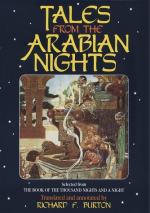The ghoul-wife of Arabian tales, who eats little or nothing at home, has her in the rakshasi of Indian fictions, who secretly devours antelopes, etc. There are many parallels in The Nights and other Asiatic story-books to the incident of Sidi Nu’man being changed back into his proper form, the most noteworthy being perhaps the case of the Second Calender in the shape of a monkey, or ape, whom the princess, an adept in white magic, at once recognizes as a man and veils her face, as does the young woman in the case of Sidi Nu’man: but while the Calender is restored to his own form, the princess, alas! perishes in her encounter with the genie who had transformed him.—In most of the Arabian tales of magical transformations of men and women into beasts the victims are ultimately restored to their natural forms, but in the Indian romance of the princess Somasekhara and Chitrasekhara, a wicked king named Ugrabahu is permanently changed by some water taken from a magic fountain into a monkey and sold to a beggar, who compels him to perform tricks in public for his benefit. Heywood, in his “History of Women” (Book viii.), cites some curious European stories of men being transformed into donkeys by eating a certain kind of cheese,
History of Khwajah Hasan Al-habbal—p. 198.
How this entertaining story found its way into North Germany—and nowhere else in Europe, so far as I am aware—it is not easy to say, but its twin-brother seems to be orally current there, in all essential details, excepting the marvellous conclusion. For the poor ropemaker, however, a struggling weaver and for the two gentlemen, Sa’d and Sa’di, three rich students are substituted. There does not appear (according to the version given by Thorpe in his “Yule Tide Stories,” which he entitles, not inaptly, The Three Gifts) to be any difference of opinion among the students regarding the influence of Destiny, or Fate, upon men’s fortunes: they simply give the poor weaver a hundred dollars “to assist him in his housekeeping.” The weaver hides the money in a heap of rags, unknown to his wife, who sells them to a rag-collector for a trifling sum. A year afterwards the students are again passing the house of the weaver and find him poorer than ever. He tells them of his mishap




